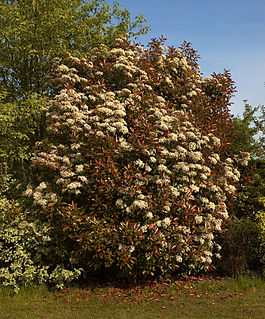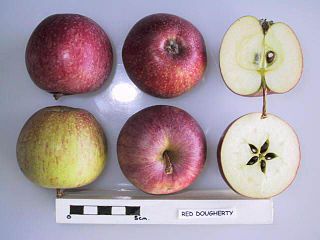
Pluots, apriums, apriplums, or plumcots, are some of the hybrids between different Prunus species that are also called interspecific plums. Whereas plumcots and apriplums are first-generation hybrids between a plum parent and an apricot, pluots and apriums are later-generations. Both names "plumcot" and "apriplum" have been used for trees derived from a plum seed parent, and are therefore equivalent.

Crataegus, commonly called hawthorn, quickthorn, thornapple, May-tree, whitethorn, or hawberry, is a genus of several hundred species of shrubs and trees in the family Rosaceae, native to temperate regions of the Northern Hemisphere in Europe, Asia, North Africa, and North America. The name "hawthorn" was originally applied to the species native to northern Europe, especially the common hawthorn C. monogyna, and the unmodified name is often so used in Britain and Ireland. The name is now also applied to the entire genus and to the related Asian genus Rhaphiolepis.

Photinia is a genus of about 40–60 species of small trees and large shrubs, but the taxonomy has recently varied greatly, with the genera Heteromeles, Stranvaesia and Aronia sometimes included in Photinia.

The garden dart is a moth of the family Noctuidae. It is distributed throughout much of the Palearctic. Temperate regions of Europe, Central Asia and North Asia, as well as the mountains of North Africa. Absent from polar regions, on Iceland and some Mediterranean islands, as well as in Macaronesia.
The name Crataegus columbiana is a source of considerable confusion. The species named by Thomas J. Howell is now considered to be the same as C. douglasii, named earlier, and the earlier name should be used instead. However, some varieties of C. columbiana have also been named that are not related to C. douglasii. C. columbiana has been used by some authors for Crataegus piperiBritton, which is now known as C. chrysocarpa var. piperi.

Crataegus azarolus is a species of hawthorn known by the common names azarole, azerole, and Mediterranean medlar. It is native to the Mediterranean Basin and is a common plant there, growing on sites comparable to those the European common hawthorn grows on. In the Arab countries it is the most common hawthorn species. When growing in the wild, the azerole bears plentiful crops of haw fruits, which are similar to the haws of the European common hawthorn, but more plump.
Crataegus boyntonii is a species of hawthorn native to the southeastern United States. Its fruit are "yellow-green flushed with red". It is sometimes considered to be a synonym of Crataegus intricata.

Crataegus chrysocarpa is a species of hawthorn that is native to much of the continental United States and Canada. Common names fireberry hawthorn and goldenberry hawthorn, as well as the scientific name all refer to the colour of the unripe fruit, although the mature fruit is red and in var. vernonensis is "deep claret-colored … nearly black when over-ripe".

Crataegus crus-galli is a species of hawthorn known by the common names cockspur hawthorn and cockspur thorn. It is native to eastern North America from Ontario to Texas to Florida, and it is widely used in horticulture. It is thought to be the parent, along with Crataegus succulenta, of the tetraploid species Crataegus persimilis.

Crataegus marshallii is a species of hawthorn known by the common name parsley hawthorn. It is native to the southeastern United States.

Crataegus orientalis, known as oriental hawthorn, is a species of hawthorn native to the Mediterranean region, Turkey, Caucasia, Crimea, and western Iran, with fruits that are orange or various shades of red.

Crataegus punctata is a species of hawthorn known by the common names dotted hawthorn or white haw that is native to most of the eastern United States and eastern Canada. While some sources claim it is the state flower of Missouri, the actual legislation does not identify an exact species. Furthermore, the Missouri Department of Conservation asserts the Crataegus mollis was specifically designated as the state flower.

Crataegus tanacetifolia, the tansy-leaved thorn, is a species of hawthorn. It is native to Turkey where it occurs on dry slopes or in rocky places, usually on calcareous rocks.

Crataegus mexicana is a species of hawthorn known by the common names tejocote, manzanita, tejocotera and Mexican hawthorn. It is native to the mountains of Mexico and parts of Guatemala, and has been introduced in the Andes. The fruit of this species is one of the most useful among hawthorns.
Crataegus sargentii is a species of hawthorn from the southeastern United States, commonly called Sargent's hawthorn. It is a shrub to about 5 m in height with white flowers, and fruit up to about 1 cm in diameter that are yellow or yellow flushed with pink or red.

Crataegus pulcherrima is a species of Hawthorn native to the southeastern United States. This species and those related to it that are classified in Crataegus series Pulcherrimae have been largely ignored since they were originally described in 1903, but warrant consideration as ornamental cultivated plants.

Crataegus pycnoloba is a species of hawthorn in the Rosaceae family. It is native to the mountains of the northern and central Peloponnesus of Greece. The plant is a shrub or rarely a small tree. The fruit are red or dark reddish brown when immature, but later develop a yellow background colour.

'Dougherty' was an Australian cultivar of domesticated apple, which was grown mainly for export to the United Kingdom, from which a red colored mutation is marketed today as 'Red Dougherty'. 'Dougherty' produces medium-sized fruits at late season, skin background is greenish-yellow and flushed with some red. Flesh is yellowish with sweet flavour.

Section Coccineae is a section within the genus Crataegus that includes the majority of North American hawthorn diversity. It includes at least 20 series as well as some species that have not yet been assigned to series.